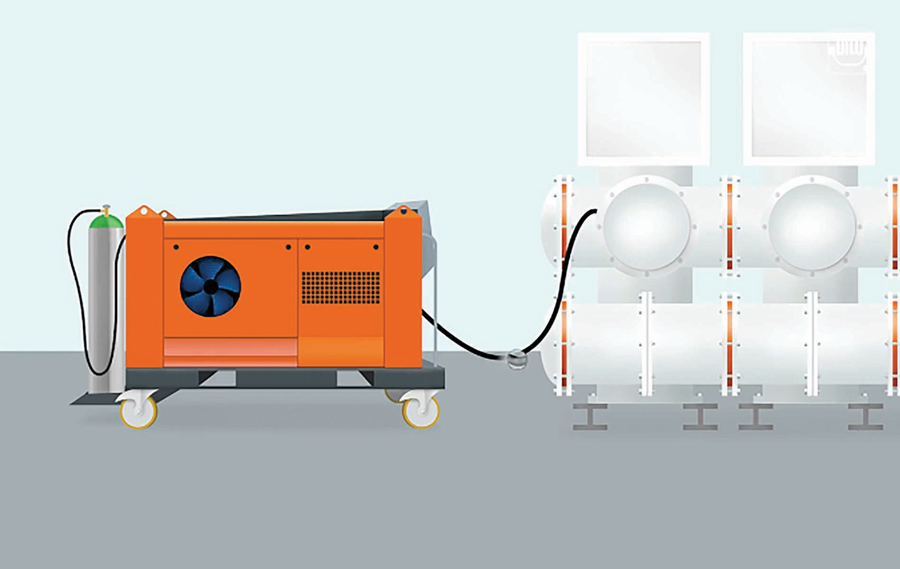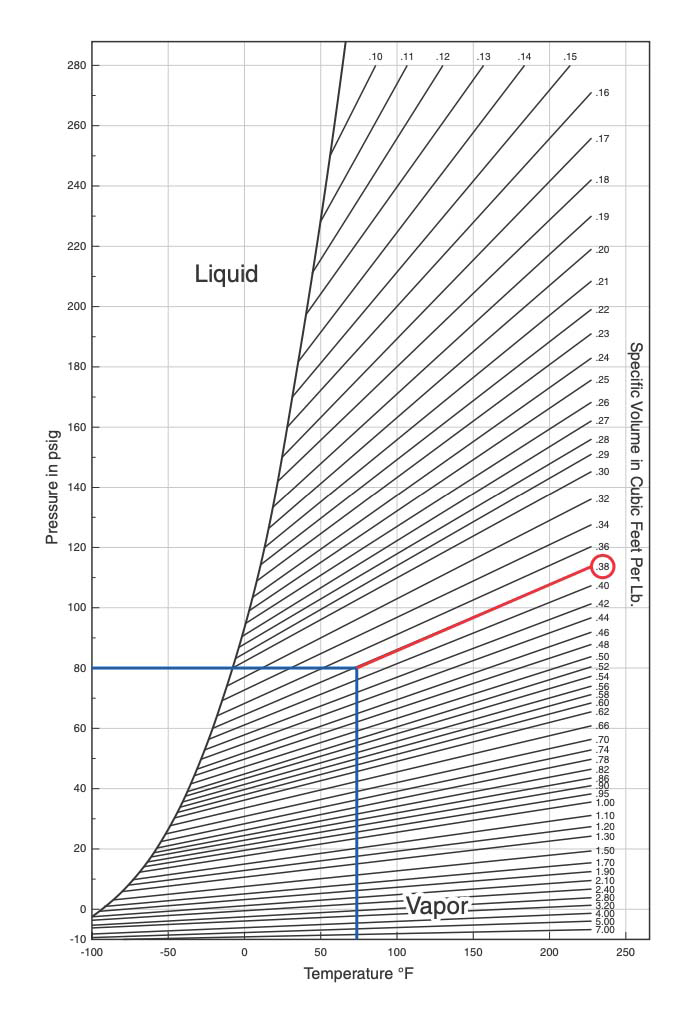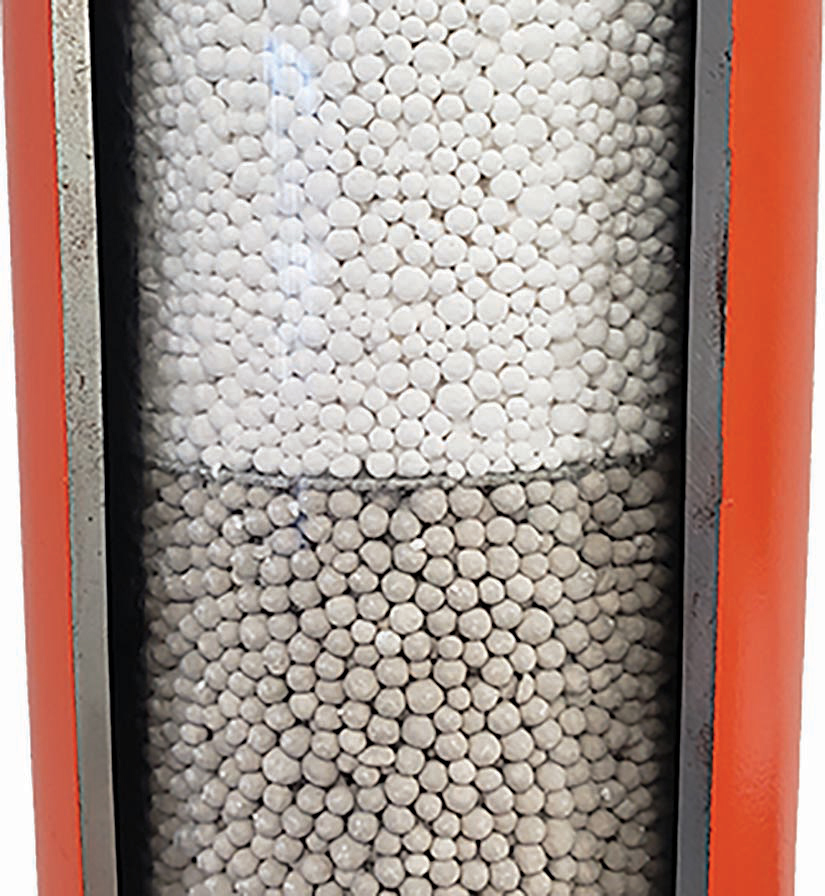The ability of SF₆ to recombine after arcing events — combined with the fact that it is chemically inert, non-toxic in its pure state, non-flammable, and very-high density — makes it an excellent di-electric gas, and sulfur hexafluoride has been used as an insulating medium in the electrical industry since the 1950s.
SF6 GAS ENVIRONMENTAL IMPACT
SF₆ is a man-made gas that does not naturally occur in large quantities. In 1997, the Kyoto Protocol (Global Warming Treaty) listed SF₆ gas as one of the six greenhouse gases that should be controlled by reducing emissions or eliminating its use. The Global Warming Potential (GWP) of a gas measures the amount of energy the emissions of 1 ton of that gas will absorb relative to 1 ton of carbon dioxide (CO2). Gases with a higher GWP contribute more significantly to climate change.
SF₆ gas has been identified as the most potent greenhouse gas, surpassing others such as carbon dioxide and methane. Over the span of a 100-year period, SF₆ is 22,800 times more effective at trapping infrared radiation than an equivalent amount of CO₂. SF₆ gas is also very stable, and it accumulates in the atmosphere in an essentially undegraded state, thus having an atmospheric lifetime of 3,200 years. Therefore, even a small amount of SF₆ emitted into the atmosphere can have a significant impact on global climate change.
Despite regulations and efforts to decrease SF₆ emissions, the amount of SF₆ in the atmosphere steadily increased worldwide since 1998. There are several uses for sulfur hexafluoride, but it is most used as an insulating gas for electrical switchgear in the transmission and distribution of power industry. The industry is seeking alternatives to SF₆ due to its high GWP. However, federal regulations do not currently prohibit the purchase of new SF₆ switchgear, and most states do not have their own regulations restricting SF₆ gas.
The market for SF₆ gas is expected to grow to USD 309.8 million1 and the global installed base of SF₆ equipment is expected to grow by 75% by 20302 despite the availability of alternative solutions and data on how harmful SF₆ emissions are to the environment. The transmission and distribution industry is responsible for about 80% of SF₆ emissions, but utilizing the Three Rs of responsible SF₆ gas handling in addition to SF₆ reconditioning can help significantly reduce the industry’s environmental footprint.
THREE Rs: RE-USE, RECOVER, RECYCLE
Ideally, SF₆ should be used in a closed-loop cycle and never be emitted into the atmosphere. Unfortunately, we know this is not always the case. The most common causes of emissions in the T&D industry are production of virgin SF₆ gas, faulty or leaking gas insulated equipment (GIE), and improper gas handling methods and human error. The Three Rs address these common emission causes and help to prevent SF₆ from entering the atmosphere.
RE-USE (AND CHOOSE TO DITCH) VIRGIN SF6 GAS
The benefits of re-using SF₆ gas instead of purchasing virgin SF₆ gas include reduced environmental impact, cost savings, and increased reliability of product sourcing. Any contaminants that occur while SF₆ gas is in use due to the intrusion of air, moisture, or generation of arc byproducts can be removed with the proper filtration and separation process. SF₆ gas can be reconditioned to a like-new state that meets or exceeds IEC standards even after being exposed to an arcing event, moisture, and/or other contaminants and is approved for use within the T&D industry.

Table 1: Comparison of Emission Rates for Virgin, Reconditioned, and Recycled SF₆ Gas
Environmental Impact of Virgin Gas
The production of virgin SF₆ gas is a major source of emissions. The International Panel on Climate Change’s 2019 Guidelines for National Greenhouse Gas Inventories estimates that 0.03 kg to 0.08 kg of SF₆ gas is emitted to the atmosphere per every 1 kg (2.2 lbs) of SF₆ gas produced.3 In fact, producing virgin SF₆ gas can create 12.5 or more times the emissions than reconditioning or recycling SF₆ gas for re-use.
One way to curb emissions while using SF₆ gas is to switch from purchasing virgin gas to using reconditioned gas. A large and growing stockpile of SF₆ gas is already in circulation in North America. From an environmental perspective, reconditioning gas helps us lower the carbon footprint by removing the need to produce more SF₆ gas. Additionally, utilizing SF₆ gas already in the United States helps reduce emissions created by the manufacturing and shipping of virgin gas from overseas.
Increased Reliability and Decreased Cost
It is important to recognize that the major shareholders of manufacturing virgin SF₆ gas come from industrial gas production plants outside of North America. Virgin SF₆ gas production was ceased in the United States with the greenhouse gas emission reduction targets instituted by the Environmental Protection Agency. Therefore, any virgin SF₆ gas purchased in the United States is imported from Eastern Europe, Russia, or Asia where the gas is produced. Given current supply chain issues and increased demand, virgin SF₆ gas has never been more expensive or difficult to source.
Reconditioned SF₆ gas can be sourced from vendors within the United States, decreasing shipping costs and delays. The SF₆ reconditioning practice ensures a readily available supply for the power and utility sectors and eliminates the need and environmental impact of importing virgin product from other continents.
An additional advantage for sourcing reconditioned SF₆ is cost savings. Virgin gas typically costs double what reconditioned SF₆ gas costs. Technological advances in the filtration and separation process make it possible for reconditioned SF₆ to meet or exceed federal and international industry standards, all at a lower cost, and this cost savings does not compromise the quality of the gas.
From a technological view, there are no significant differences in the makeup of engineered virgin SF₆ and reconditioned SF₆ that has undergone a cryogenic process to remove by-products. Furthermore, reconditioned SF₆ gas can be purchased at significantly lower cost than virgin gas while simultaneously supporting American businesses.
RECOVER CORRECTLY
SF₆ gas recovery (Figure 1) refers to the process of capturing or removing gas from GIE via a recovery system. In addition to removing the gas from the GIE, the recovery system provides basic filtration of contaminants like moisture, SF₆ gas by-products, and sometimes oil.

Figure 1: Recovery of SF₆ Gas from GIE Using a SF₆ Gas Cart
Three important things to keep in mind for SF₆ gas recovery:
- Determine the volume of SF₆ gas. It’s critical to determine the volume of SF₆ gas to be recovered to select the correct tools and equipment and avoid emissions. The following formula can be used to determine the volume of SF₆ gas:
Volume (ft3) / density = lbs
An SF₆ density curve like the one in Figure 2 can help determine the density using the size of the GIE compartment and the ambient temperature. Next, the density along with the volume of the GIE are used to determine the approximate pounds of SF₆ gas to be recovered.

Figure 2: SF₆ Density Curve
- Recover to blank-off pressure. When completing SF₆ recovery using a gas cart, it is imperative to reach the lowest level of vacuum possible — blank-off pressure. Generally, reducing the amount of gas in a breaker to atmospheric pressure alone leaves a startling 14–18% of residual gas within the GIE. Starting additional maintenance while residual gas is still present can cause an emission.For volumes under 100 lbs. of SF₆ gas, the minimum blank-off pressure is <5 mbar. For volumes over 100 lbs. of SF₆ gas, the minimum blank-off pressure is <1 mbar. Recovering to blank-off pressure removes virtually all the gas from the GIE and reduces emissions caused by residual gas being emitted into the atmosphere when the GIE is opened for maintenance.
- Use the correct size recovery equipment. It is extremely important to use an adequately sized recovery system for the volume of SF₆ gas that needs to be recovered. Hose length should also be considered. Utilizing an undersized recovery system for the volume of SF₆ to be recovered will leave residual gas in the GIE that can lead to an emission.
RECYCLE VIA ON-SITE FILTRATION
Contamination of SF₆ gas can occur naturally over time through leaks and arcing events.
Common contaminants found in SF₆ gas include decomposition by-products, oil, and moisture. It’s important to test the quality of SF₆ gas via a zero-emission analyzer prior to beginning any gas handling as certain contaminants like SF₆ by-products can be hazardous to human health and damage equipment.
Depending on the quality and purity of SF₆ gas, the gas can be recycled on-site. Except for air, nitrogen, carbon tetrafluoride (CF4), and other vapors, most contaminants can also be removed on-site using a recovery system and external pre-filters. This recycling allows contaminated SF₆ gas to be processed on-site and quickly returned to your company’s inventory and/or be filled back into GIE.
Four main types of filtration can be performed on-site to allow for SF₆ recycling (Figure 3):

Figure 3: Particle Filter Used to Trap Solid Contaminants in SF₆ Gas
- Aluminum oxide (AL₂O₃). Aluminum oxide absorbs moisture and SF₆ by-products from SF₆ gas by attracting and trapping the particles as the vapor passes through the filter.
- Molecular sieve desiccant. The desiccant traps water molecules and removes them from the SF₆ gas as it passes through the filter.
- Particle filter. The particle filter traps any solid particles in the SF₆ gas as it passes through the filter. These particles may include solid decomposition material from SF₆ gas by-products that would damage the GIE and gas handling equipment. Particle filters have a 100% capture rate of particles ≥1.0 µm.
- Activated charcoal. The high surface area of activated charcoal along with high bulk density and particle size distribution allow it to remove organic compounds such as oil from SF₆ gas. The activated charcoal filter is not a standard part of a recovery system but can be used externally if gas analysis shows that oil is present as a contaminant.
Most recovery systems include aluminum oxide, molecular sieve desiccant, and particle filters. Using a pre-filter provides extra filtration to protect the recovery system from any contaminants present in the gas and makes the recycling process more efficient by providing extra filtration.
It may take multiple passes through the recovery system and pre-filter to recycle the gas to meet IEC standards for re-use. If you do not see a significant improvement in gas quality after filtration, your filters could be saturated and will likely need to be cleaned or replaced. Please note that cleaning may require PPE and special handling processes that require specific training or certifications (i.e., a respirator program). If the IEC standard for re-use cannot be met or exceeded, the SF₆ gas will have to be sent for reconditioning.
Reconditioning SF6 Gas
In some cases, SF₆ gas may need to be reconditioned to remove vapors prior to being re-introduced into the supply stream. Reconditioning is a process that occurs after the Three Rs are used to separate SF₆ gas from other vapors (N2, O2, CF4). The reconditioning process requires special equipment and handling procedures that ensure as close to zero emissions as possible.
An SF₆ gas separator uses a three-stage cryogenic process to recondition SF₆ gas to a guaranteed 99% purity and less than 99.5 ppmV moisture. In short, reconditioning is a cryogenic process that is combined with filtration and high pressure through an emission-free process. The end goal is to meet or exceed the standards set by CIGRE, IEEE, ASTME, and IEC. When the process is followed correctly, the standards can easily be exceeded and the gas can be returned to the market for re-use.
CONCLUSION
SF₆ gas is an extremely effective di-electric gas that contributes significantly to global warming when emitted to the atmosphere due to its high GWP. Data shows that using SF₆ gas and switchgear will grow by 2030 despite the known environmental impact of SF₆ gas and the availability of alternatives. By utilizing the Three Rs (Re-use, Recovery, and Recycling) along with SF₆ reconditioning, the T&D industry can significantly reduce its environmental footprint while continuing to use the gas.
REFERENCES
1. Grand View Research. Sulfur Hexafluoride Market Size, Share: Industry Report. Available at https://www.grandviewresearch.com/industry-analysis/sulfur-hexafluoride-sf6-market.
2. McGrath, Matt. “Climate Change: Electrical Industry’s ‘Dirty Secret’ Boosts Warming.” September 2019. Available at https://www.bbc.com/news/science-environment-49567197.
3. IPCC. Refinement to the 2006 IPCC Guidelines for National Greenhouse Gas Inventories. May 2019. Available at https://www.ipcc.ch/report/2019-refinement-to-the-2006-ipcc-guidelines-for-national-greenhouse-gas-inventories/.
 Corey Ratza is the Sales Director for DILO Company, Inc. With over a decade of dedication to DILO Company Inc., Corey has experience with the professional development and management of the sales and marketing team, strategic sales and marketing campaigns, and cross-department collaboration. Corey’s mechanical, technical, and marketing background supports his leadership and accountability of DILO’s brand stewardship. Corey serves as an integral advisor for new product and service development and works to garner and maximize new market segments and business growth.
Corey Ratza is the Sales Director for DILO Company, Inc. With over a decade of dedication to DILO Company Inc., Corey has experience with the professional development and management of the sales and marketing team, strategic sales and marketing campaigns, and cross-department collaboration. Corey’s mechanical, technical, and marketing background supports his leadership and accountability of DILO’s brand stewardship. Corey serves as an integral advisor for new product and service development and works to garner and maximize new market segments and business growth.
 Lina Encinias is the Marketing and Training Manager for DILO Company, Inc. and is passionate about DILO’s slogan “ONE VISION. ZERO EMISSIONS.” Lina helps spread awareness on preventing SF6 emissions, regulations, and responsible gas handling through the DILO Blog, the Annual SF6 Gas Management Seminar, and industry trainings.
Lina Encinias is the Marketing and Training Manager for DILO Company, Inc. and is passionate about DILO’s slogan “ONE VISION. ZERO EMISSIONS.” Lina helps spread awareness on preventing SF6 emissions, regulations, and responsible gas handling through the DILO Blog, the Annual SF6 Gas Management Seminar, and industry trainings.